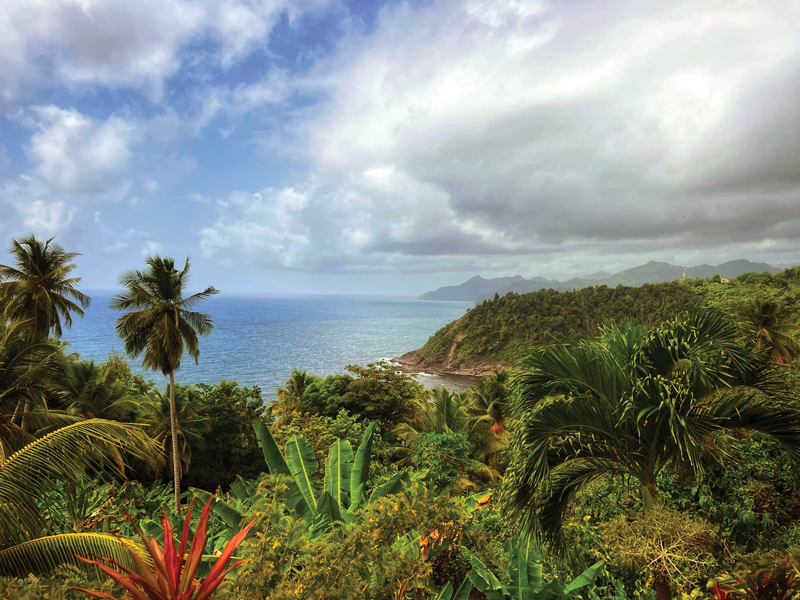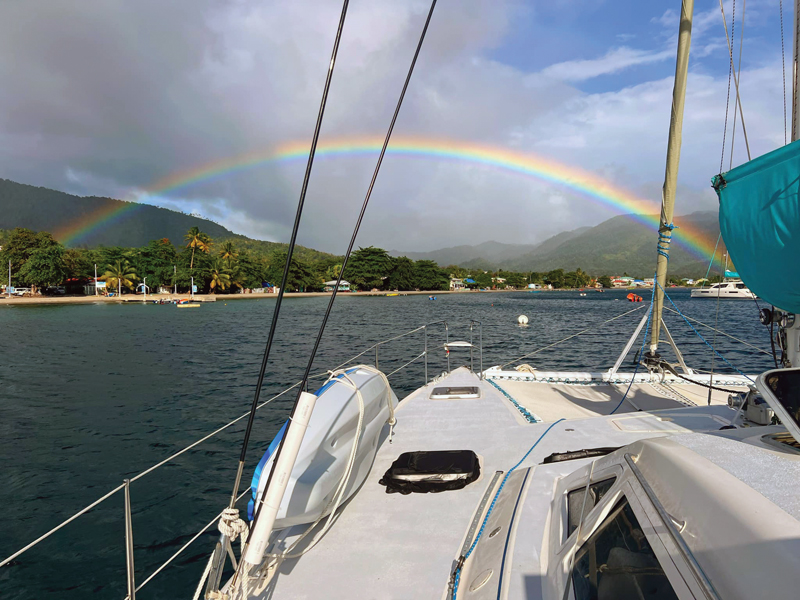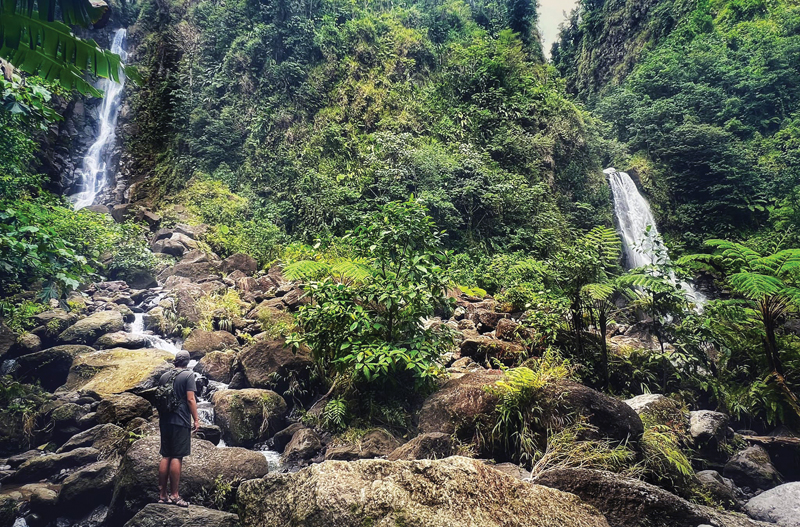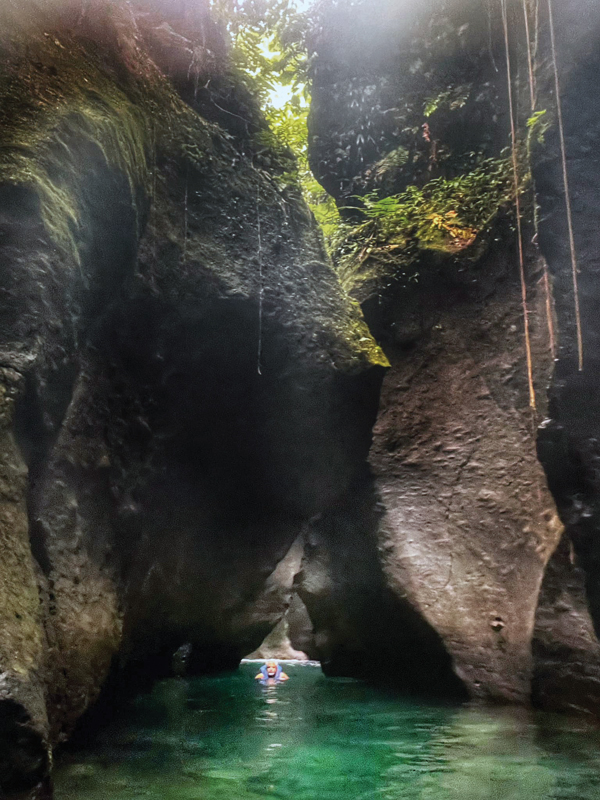Cruising to Dominica
The wind bullied us all the way into Portsmouth Harbor in Dominica. We left Guadeloupe in a chaotic squall and arrived in a stiff 30 knots. Clawing our way through the anchorage, we looked for a sweet spot in the lee of the island where the wind would leave us alone. A panga pulled up and motioned to us, and we gladly followed him. He circled a mooring ball right by the beach and reached out for me to throw him our line.
I yelled back to my husband, “Let’s try not to swallow him between the hulls.”

The choreographed ballet of a blustery mooring ball hookup went smoothly, and the wind scurried off to pester another piece of ocean. A few minutes later a juicy rainbow burst onto the scene to welcome us to Dominica.
Now, it’s time for a geography lesson. Dominica is not the Dominican Republic. DR is a large Spanish speaking nation that shares roughly half of the huge island of Hispaniola, situated between Cuba and Puerto Rico. To see Dominica, you need to zoom all the way in on a map between Guadeloupe and Martinique. Keep zooming. Yeah, there she is.

The only thing the two places have in common is that good ol’ Christopher Columbus disregarded that there were thriving native cultures in both places and renamed both islands using almost the same name. He didn’t even step foot on Dominica. He sailed past on a balmy Sunday in 1493, and since he was a better navigator than a wordsmith, he simply called the island... Sunday (in Latin). The Kalinago people who lived here originally called the island Wai‘tu kubuli, which means “Tall is her body.” And it’s easy to see why.
Long, lanky waterfalls cascade off towering, emerald mountains all over this island that’s slightly smaller than New York City. Dominica is lush, clean, and jaw-droppingly beautiful at every turn. But let’s talk about those turns. Driving in Dominica is for the brave and religious. Stick shift on the “wrong side” of the road; it’s a constant game of chicken with death drops on every curve. As such, we hired a driver-guide to take us around.

First stop was Morne Trois Pitons National Park, home to the twin Trafalgar falls. This place made me understand why the Kalinago viewed their island as a powerful woman. We splashed in the pristine waters pooling among the large boulders and marveled at how we were the only ones there. With nothing but the sound of the birds and the thundering of the falls, it felt as if we had stepped back in time.
Dominica is known for the boiling lakes that bubble up from geothermal activity on the island. There is an epic eight-hour round trip hike uphill and in the heat that will take you to these boiling lakes. Our driver could see we are not eight-hour-hike sort of people and said, “Don’t worry. No need to hike. I know a place.”
He wound us into a neighborhood, pointed down a path, and with a two-minute walk, we were on a viewing platform at the edge of a mini-boiling lake. We stood there sweating for a few minutes before the heat became suffocating.

Needing to cool off, we headed to the refreshing waters of Titou Gorge. The gorge is an undulating, narrow passage tangled in verdant jungle greens. The water is so blue-green that it looks like dyed mini-golf water, except pure and very, very cold. Swimming deeper into the gorge, we found a waterfall tucked away in the back. It was a hidden gem, inside a hidden gem, inside a hidden gem. I floated around in awe, thinking that it looked like a completely natural version of a planned water park attraction.
Unlike a water park, there is just about no trash around Dominica. Compared to so many places in the Caribbean where garbage is a problem on land and sea, it’s a lovely surprise to see beaches and communities without piles of single-use plastic and food wrappers.
Our driver told us proudly how each neighborhood has a designated clean-up crew and caretakers for the plants and trees: “We can’t call ourselves The Nature Island if we don’t take care of nature. It’s part of our culture. It’s what we teach our children.”
We found the same pristine pride rowing up the Indian River back in Portsmouth. Only human powered crafts are allowed on this river. A guide rows you slow and easy and helps you forget the modern world one long stroke at a time. Curious iguanas stared at us from the low-hanging branches, while meaty crabs scurried into mud holes. The regal, worry-free birds knew that this was their turf and that we were merely passing through.
The ones who are not merely passing through are the Kalinago people who still remain on the island. Their numbers have dwindled, but their dignity remains strong. We got to tour the Kalinago territory and learn from storytellers, herbalists, and a chief who welcomed our group and shared some traditional songs and dances. The Kalinago are the keepers of Wai‘tu kubuli and they make sure this place lives up to the spirit of her original name.
Too bad Columbus didn’t take the time to get to know this place, not that deep connection with the land and indigenous peoples were exactly his strong suit. Don’t sail on by like Chris. This is a place worth getting to know.
by Cindy Wallach




